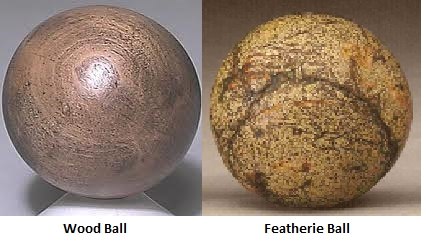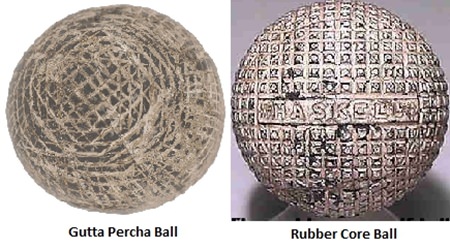Many believe the first golf balls were wooden, made from elm or beech trees and imported from Holland; however there is no evidence to support such a claim. The first balls that were recognised as golf balls, and written about, were made of leather and stuffed with duck and geese feathers – thus the name “featherie”.
Records dating from the mid-15th century show Scottish golfers paying up to 10 shillings for a well-made featherie, a large amount back then. The ball was created by stuffing wet feathers – enough to fill a gentleman’s top-hat – into a small wet pouch. The pouch was then sewn up and left to dry. The feathers would expand and the leather shrink, thus creating a small, hard and resilient projectile.


This ball certainly met expectations, as noted by the chronicles of St Andrews which recorded a drive of 361 yards in 1836. But due to its manufacture being labour intensive, the high cost kept many from taking the game up. This changed in the 1850s with the introduction of the gutta-percha ball.
This ball, invented by Scottish engineer and inventor, Dr Robert Adams Paterson, was made from dried sap of the sapodilla tree, found in SE Asia. The sap, which had a rubbery-like texture, was made round by heating and shaping in a spherical mould. The balls, referred to as “gutties”, were cheap to produce and could be reformed if misshapen or damaged.
Gutties were originally smooth, but it soon became apparent through general use that balls that suffered cuts or abrasions to their surface actually flew better and gave a more consistent ball flight. Thus manufactures started carving a patterned surface across the face of the guttie, which became known as the guttie-brambles due to their resemblance to bramble fruit. The guttie’s relatively cheap production cost brought about a boom in playing numbers.
Fifty years later, just before the turn of the century, Coburn Haskell, of Cleveland, Ohio was visiting the BF Goodrich tyre company. While waiting for his golfing partner to emerge, he picked up some rubber thread and wound it tightly into a small ball. When he bounced it he was amazed to see it flew almost to the ceiling. He decided to put a cover on his wound rubber ball and in so doing produced the Haskell rubber-core golf ball. These balls weighed around 1.5 ounces and were the first to be mass produced.
Following the end of the First World War, golfing numbers increased rapidly, particularly in the US. In 1920 the R&A and the USGA saw the need to regulate the golf ball in order to retain course integrity. They agreed the power of the ball should be limited. Thus, with effect from May 1921, they decreed that the weight of the ball shall not be greater than 1.62 ounces and the size not less than 1.62 inches in diameter.
Notwithstanding, American golf was introduced to a bigger ball during the 1930s. This 1.68 inch ball became known as the American Ball, whilst it smaller version was referred to as the British Ball. It wasn’t until 1990 that the smaller British Ball was discontinued.
The surface of golf balls became the subject of much research. Dimple patterns were first introduced in 1908, when they replaced the mesh and bramble designs used previously. The rubber thread was wound around a rubber core as tightly as possible, before being cased within a balata cover.
Balata is the name given to a type of tree that grows in Central and South America. The tree is tapped allowing the viscous fluid to harden into a rubber-like material before being applied to cover the wound rubber ball.
In the mid-1960s, synthetic resins called surlyn and urethane were introduced. Soon golf balls became classified as two-piece, three-piece, or four-piece balls according to the number of layered components.
These days, golf balls boast a vast array of features designed to fit a golfer’s particular playing characteristics. An individual’s swing-speed will tend to dictate which ball is best suited for his/her game. Most manufactures will indicate which ball suits what swing-speed. The ever-popular Titleist Pro V1 or Pro V1x, for example, are wasted on the majority of amateur golfers as they do not generate sufficient club-head speed that the ball is designed for. Such golfers, those with a club-head speed less than say 90mph, are far better off using balls designed specifically for the slower swinger. Not only will they gain greater distance, they will likely reduce what they currently spend on purchasing golf balls.
Heard of Samuel Messieux? He was the golfer who hit that featherie ball 361 yards at St Andrews, in 1836. He must have used a club with a titanium head and steel shaft, surely?
Happy golfing,
Golfnutter




